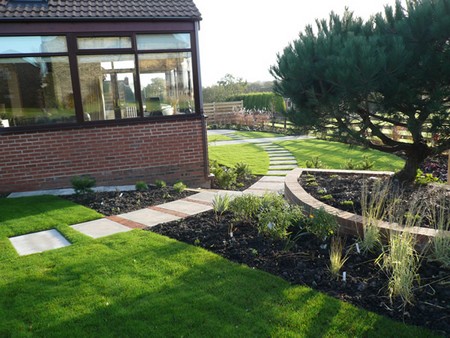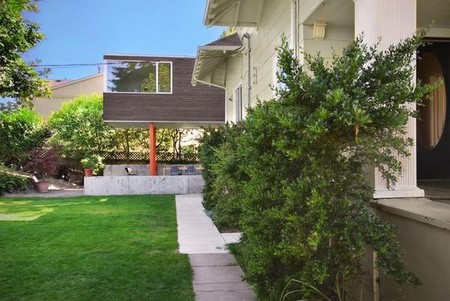The Difficult shape of this garden has been turn to advantage by a clever design, which both softens the line of the ‘L’ and links the two areas together, drawing the visitor on to explore further. The planting is at once elegant and exciting, complementing the simple materials used for the hard landscaping.
Although this garden is a strong L shape, the space in the central area has been formed into a curve, thereby softening the impact of the rather angular plot. The bold, linear design integrates the two parts of the garden, and the use of the same paving material for both parts further links and unites the two areas.
The design uses the change of level as a natural divide. The lower area is planted with easy-care shrubs and plants to give lots of foliage interest and colour, while the upper part is a secluded, pretty sitting area. The pattern of bright white squares edged with tiny red bricks is striking, creating a well-defined surface that makes a strong design statement carried through both parts of the garden. Keeping the hard landscaping in geometrical lines and softening it with lush and varied plants provides the ideal solution to this potentially puzzling shape, and makes this garden inviting and interesting.
Features
Although the garden is based largely on squares and rectangles, the hard edges are softened by the use of plants that will grow over and around them.
The materials chosen contrast strongly with each other and, because the flooring is so dazzling, the number of different surfaces is limited. The high walls, which act as a windbreak and offer privacy, are painted white, to show off the foliage and reflect light into the garden. The steps between the two levels are grey to complement those descending to ground level from the flat above.
Light is used well in this garden, with the open central area strongly reflecting sunlight. This contrasts with the cool, shady corner created by Escallonia ‘Langleyensis’, Fraxinus ornus and Deutzia x hybrida ‘Mont Rose’ and the deep green of the shrubs. An overlooked corner has been densely planted with taller shrubs to create privacy and shade. White pavers reflect the light and make the garden seem spacious and airy.
Planting
By heavily disguising the boundaries with planting, the awkward shape of the plot is effectively lost, yet the garden retains the surprise of having a hidden area. Planting is confined largely to the edges, but interest is created by introducing variation into the depths of the beds, and bamboos are included because their elegant, tall, narrow shapes break up the walls.
L-shaped gardens provide the ideal opportunity to create surprises, and the beautiful small trees and ferns in the raised bed behind the seating area will be a delightful find. From the house, the chairs and table can just be glimpsed, giving the illusion of space and confirming the existence of another part to the garden.
Although the hard landscaping uses only a few different materials and textures, the same cannot be said for the plants in this garden. From the blue-grey oval leaves of Eucalyptus delegatensis, the tall, angular Hemerocallis ‘Sugar Cookie’ and the easy poise of Fargesia murieliae (umbrella bamboo) to the gentle elegance of the ferns, there is a wonderful mixture of shapes, texture and colour, providing constant interest everywhere you look. Who needs lots of colours and textures in the materials when you have this much excitement in the planting?
The raised beds by the steps serve to lift the planting easily to the higher level, helping the eye to travel from one area to the other. The unplanted urn, placed on the wall, provides an attractive focal point halfway along the garden.
In the higher part of the garden, some aromatic plants are used to create a fragrant atmosphere and a relaxed feel. Spring and summer bulbs are used to provide masses of colour in different areas over a prolonged period so that the garden will always be interesting and inviting.
The small trees, ferns and raised side beds used in this part of the garden are in direct contrast to the rangier, less organized planting in the rest of the garden, and using different types of planting in each ‘leg’ of the plot clearly differentiates between the two areas, which are nevertheless firmly linked by the paving.
It is important to have strong design elements at the point where the two parts of the garden meet. In this case, the deep, rich planting of larger shrubs gives a reason to walk to the end of the garden to see the rest of it, and the Davidia involucrata (pocket handkerchief tree) will really draw the eye to this point of the garden with its amazing flowers in spring. The uneven white bracts, which look like hundreds of tiny handkerchiefs, will form a beautiful contrast with the light green foliage and will always provide a talking point.
Categories
Advertisements
Recent Articles
 How to Understand Bed Sizes – A Small Guide
How to Understand Bed Sizes – A Small Guide How to Select Some Must Have Kitchen Accessories
How to Select Some Must Have Kitchen Accessories Best Way to Change a Car Tire
Best Way to Change a Car Tire Best Way to Write an Affirmation
Best Way to Write an Affirmation Best Way to Take Charge of Your Financial Life
Best Way to Take Charge of Your Financial Life Best Way to Survive a Party When You Don’t Know Anyone
Best Way to Survive a Party When You Don’t Know Anyone Best Way to Stop Self Sabotaging Yourself
Best Way to Stop Self Sabotaging Yourself Best Way to Start Journal Writing
Best Way to Start Journal Writing Best Way to Speak with a Powerful Voice
Best Way to Speak with a Powerful Voice Best Way to Simplify Your Life
Best Way to Simplify Your Life Best Way to Respond to a Put-Down
Best Way to Respond to a Put-Down Best Way to Reduce Acne Breakouts
Best Way to Reduce Acne Breakouts Best Way to Recover from Dining Disasters
Best Way to Recover from Dining Disasters Best Way to Quit Your Job Gracefully
Best Way to Quit Your Job Gracefully Best Way to Make Your Own Website
Best Way to Make Your Own Website



Leave a Reply